Ars Electronica Archive – S+T+ARTS
STARTS ist eine Initiative der Europäischen Kommission mit der Technologie und künstlerische Praxis bestmöglich verbunden werden sollen. Als Teil dieser Initiative unterstützen die STARTS Residencies die zukunftsträchtigsten Kooperationen und zeichnet der STARTS Preis die beeindruckendsten Ergebnisse im Bereich Kreativität und Innovation an der Schnittstelle von Wissenschaft, Technologie und Kunst aus. STARTS wird durch verschiedene Finanzierungsmodelle der Europäischen Kommission ermöglicht.
Rock Print
Gramazio Kohler Research, ETH Zurich,
Self-Assembly Lab, MIT
(In alphabetischer Reihenfolge)
260394Original: 170313_RockPrint.mp4 | 1920 * 1080px | 6m 27s | 820.3 MB
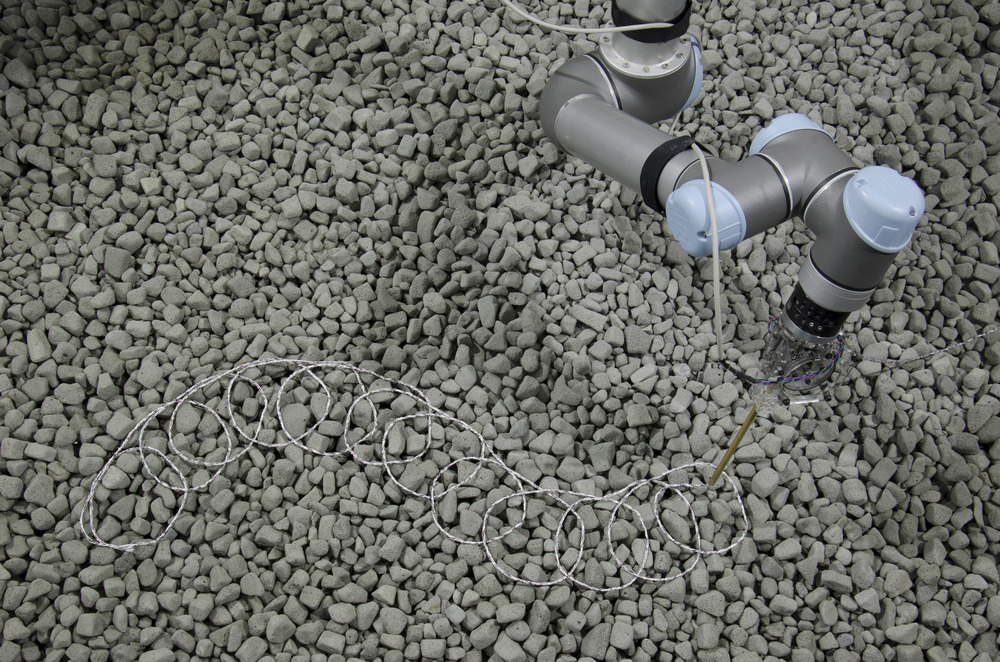
Original: 170313_RockPrintFabrication.jpg | 4928 * 3264px | 10.9 MB | 170313_RockPrintFabrication.jpg
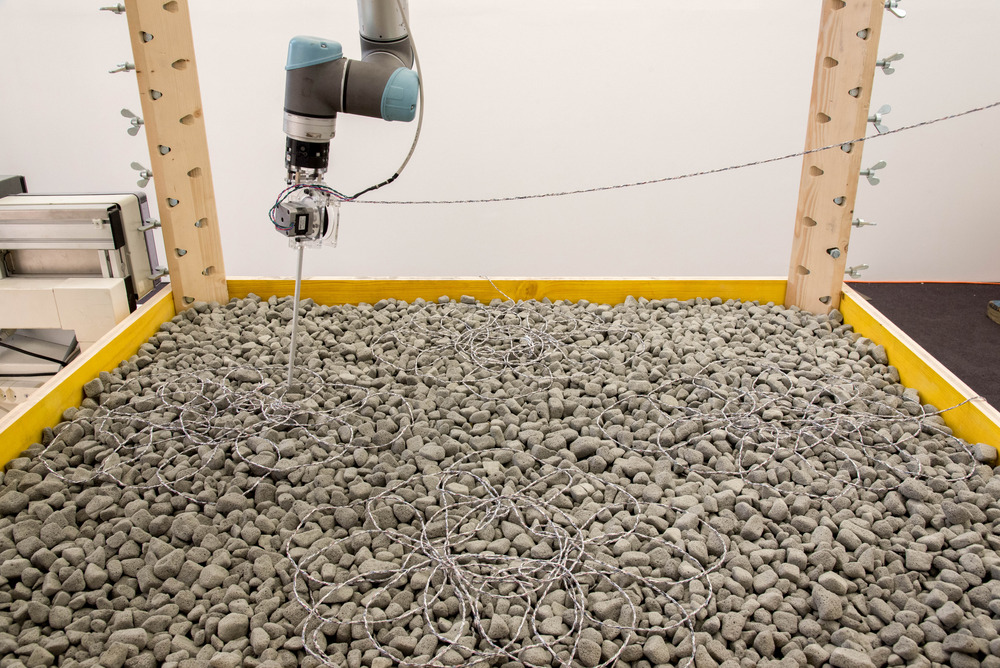
Original: SP_170422_228728_AEC_PRX_2017_rockprint_1_2411237.jpg | 6016 * 4016px | 7.7 MB | GramazioKohlerResearch
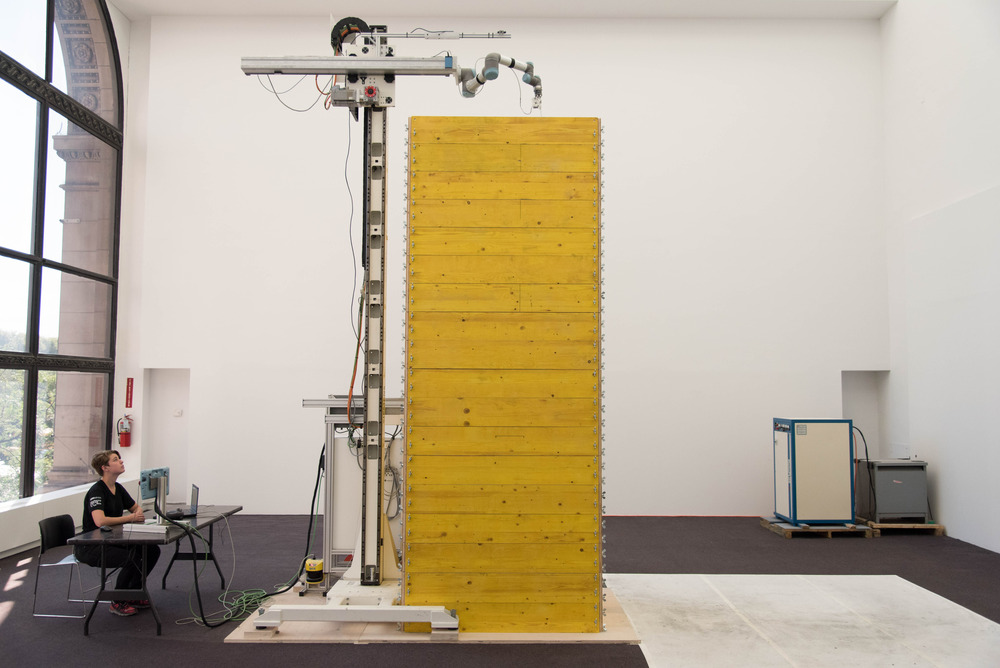
Original: SP_170422_228728_AEC_PRX_2017_rockprint_2_2411239.jpg | 6016 * 4016px | 4.4 MB | GramazioKohlerResearch
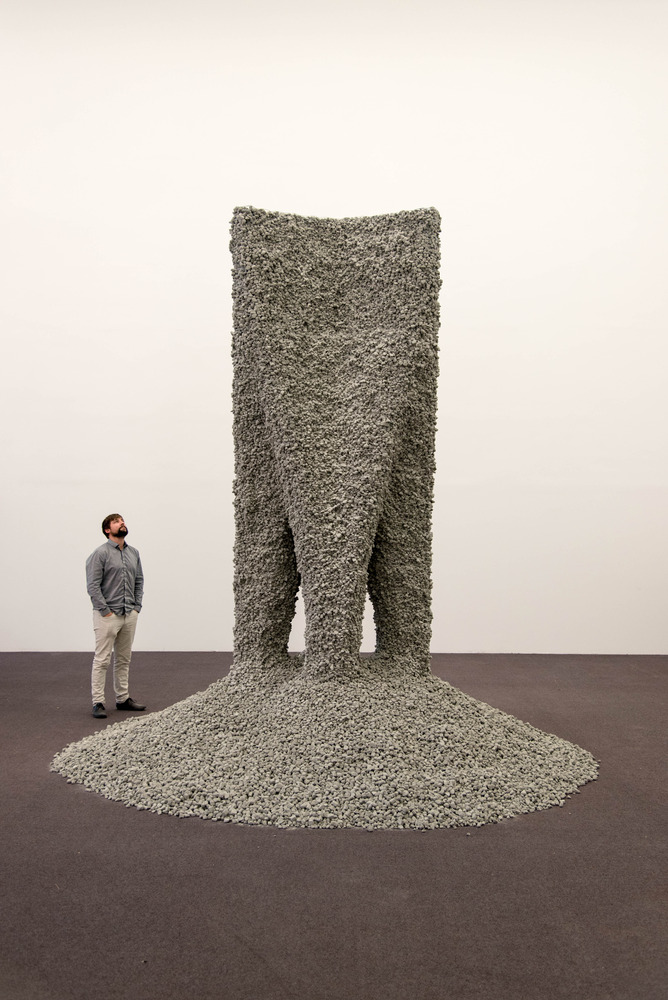
Original: SP_170422_228728_AEC_PRX_2017_rockprint_3_2411241.jpg | 4016 * 6016px | 5.8 MB | GramazioKohlerResearch
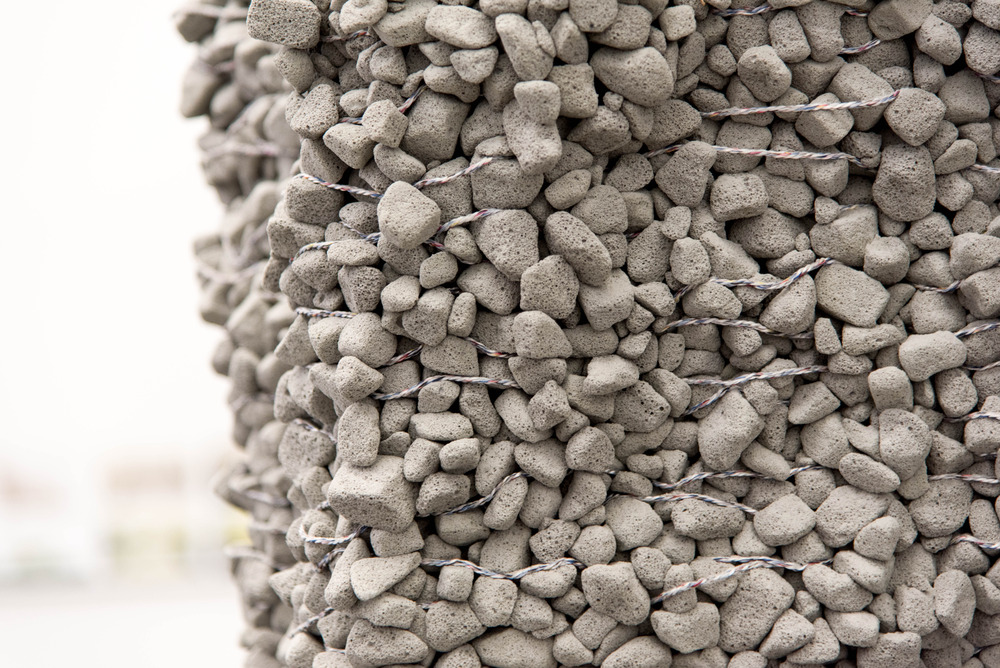
Original: SP_170422_228728_AEC_PRX_2017_rockprint_6_2411247.jpg | 6016 * 4016px | 6.2 MB | GramazioKohlerResearch
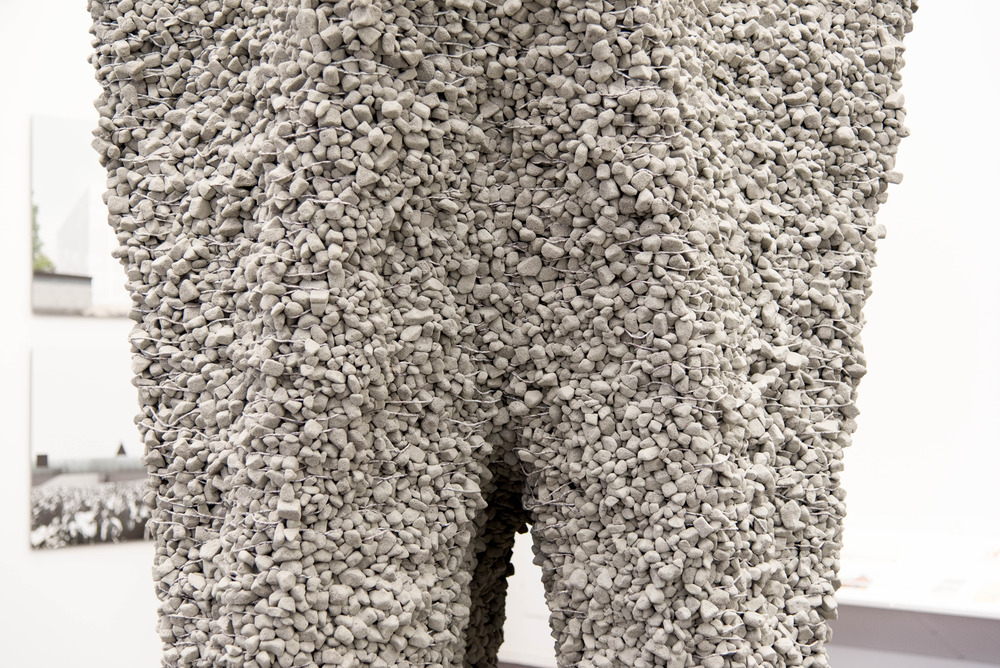
Original: SP_170422_228728_AEC_PRX_2017_rockprint_7_2411249.jpg | 6016 * 4016px | 7.5 MB | GramazioKohlerResearch
Rock Print untersucht ein als Jamming bekanntes Phänomen aus der Physik, bei dem granulare Materie von flüssigem in festen Zustand wechseln kann und vice versa. Rock Print nutzt diese Eigenschaften in einem kongruenten Konstruktionssystem, das: 1) computergestütztes Design einsetzt und mittels robotergestützter Fabrikationstechnologie realisiert wird, 2) unter Verwendung von Schüttgut minderer Qualität wie Schotter hochdifferenzierte und tragfähige Konstruktionen in architektonischem Maßstab hervorbringen kann und 3) zur Gänze rückbaubar ist. Das Konstruktionssystem funktioniert wie folgt: Um steuern zu können, wo und wie das Jamming bei Schotter einsetzt, muss die Dichte zwischen den Aggregaten auf einen Wert reduziert werden, der sie zwingt, sich wie ein Festkörper zu verhalten. Dies ist durch Verwendung einer Zugbewehrung wie einer Schnur zur Begrenzung des Schotters zu erreichen. Ein Roboterarm ermöglicht die präzise Positionierung der Schnur in einem auf einem digitalen Entwurf basierenden Muster und definiert so die Umrisse eines spezifischen architektonischen Artefakts. Zieht man an der Schnur, wird eine Kettenreaktion ausgelöst, die Schotter und Schnur in ihren ursprünglichen Zustand zurückversetzt und die Konstruktion zusammenbrechen lässt.
Rock Print wurde 2015 bei der Eröffnung der Architekturbiennale in Chicago in einem architektonischen Kontext präsentiert. Das Design ging von den Eigenschaften des Konstruktionssystems aus. Die Konstruktion erhob sich auf vier schlanken Beinen, die einen massiven auskragenden Körper trugen. Der obere Teil nimmt mehr Masse auf als der untere, um die Kompression des unteren Bereichs zu erhöhen und eine größere Oberflächenfestigkeit der Teile zu gewährleisten, die die BesucherInnen zu sehen bekamen. Rock Print wurde in situ mit einem leichtgewichtigen Roboterarm konstruiert, der mit einem auf einem Gerüst angebrachten, die Schnur auslegenden Endeffektor und einem schrittweise aufgebauten Behälter ausgestattet war. Der Behälter hatte – angepasst an den Arbeitsbereich des Roboters – die Maße 1,2 x 1,5 x 4 m, die eine vollumfängliche Nutzung desselben ermöglichten.
Rock Print wurde in einem Innenraum ausgestellt und musste aus diesem Grund leichtgewichtig sein. Daher kamen anstelle von Schotter Schaumglasaggregate (wie sie für selbstisolierenden Beton verwendet werden) zum Einsatz. Die Schnur bestand aus einer Kombination von Polyesterfasern und rezyklierten Textilien. Insgesamt wurden 8 m3 Aggregate und eine 10 km lange Schnur verwendet. Der Herstellungsprozess erfolgte in zwei Phasen. In der ersten wurde die Konstruktion im Inneren des Behälters hergestellt. Der Roboter legte gemäß Computeralgorithmen eine Schnur aus, über die manuell eine Aggregatschicht geschüttet wurde. Um eine korrekte Komprimierung der Aggregate zu gewährleisten, wurde ein Betonverdichter verwendet. Das Verfahren wurde wiederholt, bis die gesamte, aus 200 Schichten bestehende Konstruktion aufgebaut war. In der zweiten Phase wurde der Behälter abgenommen, damit die nicht verstärkten Aggregate abfallen konnten. Anschließend wurde die Konstruktion abgebürstet, um sicherzustellen, dass kein Restmaterial an der Oberfläche haftete. Die Materialreste verblieben am Boden am Fuße des Monoliths, um eine natürliche Barriere zwischen den BesucherInnen und dem Exponat zu schaffen. Rock Print wurde mit einem durchgehenden Schnurnetzes designt und konstruiert, das am Ende der Ausstellung herausgezogen werden konnte. Mithilfe eines Flaschenzugs und einer elektrisch angetriebenen Spule wurde das 10 km lange Schnurnetz abgewickelt. Nach zwei Stunden war Rock Print in das Ausgangsmaterial zurückverwandelt: einen Haufen Steine und eine Spule Schnur.
Rock Print demonstriert das Potenzial des Jammings in granularen Medien zu architektonischen Zwecken. Die Prinzipien des Phänomens sind auf ein breites Spektrum granularer Materie anwendbar, wodurch lokal vorhandene Materialien verwendet werden können. Da diese in ihren ursprünglichen Zustand zurückverwandelt werden können, eröffnen sie neue Möglichkeiten einer wirklich nachhaltigen Baumethode.
Rock Print wurde 2015 bei der Eröffnung der Architekturbiennale in Chicago in einem architektonischen Kontext präsentiert. Das Design ging von den Eigenschaften des Konstruktionssystems aus. Die Konstruktion erhob sich auf vier schlanken Beinen, die einen massiven auskragenden Körper trugen. Der obere Teil nimmt mehr Masse auf als der untere, um die Kompression des unteren Bereichs zu erhöhen und eine größere Oberflächenfestigkeit der Teile zu gewährleisten, die die BesucherInnen zu sehen bekamen. Rock Print wurde in situ mit einem leichtgewichtigen Roboterarm konstruiert, der mit einem auf einem Gerüst angebrachten, die Schnur auslegenden Endeffektor und einem schrittweise aufgebauten Behälter ausgestattet war. Der Behälter hatte – angepasst an den Arbeitsbereich des Roboters – die Maße 1,2 x 1,5 x 4 m, die eine vollumfängliche Nutzung desselben ermöglichten.
Rock Print wurde in einem Innenraum ausgestellt und musste aus diesem Grund leichtgewichtig sein. Daher kamen anstelle von Schotter Schaumglasaggregate (wie sie für selbstisolierenden Beton verwendet werden) zum Einsatz. Die Schnur bestand aus einer Kombination von Polyesterfasern und rezyklierten Textilien. Insgesamt wurden 8 m3 Aggregate und eine 10 km lange Schnur verwendet. Der Herstellungsprozess erfolgte in zwei Phasen. In der ersten wurde die Konstruktion im Inneren des Behälters hergestellt. Der Roboter legte gemäß Computeralgorithmen eine Schnur aus, über die manuell eine Aggregatschicht geschüttet wurde. Um eine korrekte Komprimierung der Aggregate zu gewährleisten, wurde ein Betonverdichter verwendet. Das Verfahren wurde wiederholt, bis die gesamte, aus 200 Schichten bestehende Konstruktion aufgebaut war. In der zweiten Phase wurde der Behälter abgenommen, damit die nicht verstärkten Aggregate abfallen konnten. Anschließend wurde die Konstruktion abgebürstet, um sicherzustellen, dass kein Restmaterial an der Oberfläche haftete. Die Materialreste verblieben am Boden am Fuße des Monoliths, um eine natürliche Barriere zwischen den BesucherInnen und dem Exponat zu schaffen. Rock Print wurde mit einem durchgehenden Schnurnetzes designt und konstruiert, das am Ende der Ausstellung herausgezogen werden konnte. Mithilfe eines Flaschenzugs und einer elektrisch angetriebenen Spule wurde das 10 km lange Schnurnetz abgewickelt. Nach zwei Stunden war Rock Print in das Ausgangsmaterial zurückverwandelt: einen Haufen Steine und eine Spule Schnur.
Rock Print demonstriert das Potenzial des Jammings in granularen Medien zu architektonischen Zwecken. Die Prinzipien des Phänomens sind auf ein breites Spektrum granularer Materie anwendbar, wodurch lokal vorhandene Materialien verwendet werden können. Da diese in ihren ursprünglichen Zustand zurückverwandelt werden können, eröffnen sie neue Möglichkeiten einer wirklich nachhaltigen Baumethode.
Collaborators: Prof. Fabio Gramazio, Prof. Matthias Kohler, Prof. Skylar Tibbits, Andreas Thoma (project lead installation), Petrus Aejmelaeus-Lindström (project lead research), Dr. Volker Helm, Sara Falcone, Jared Laucks, Lina Kara’in, Michael Lyrenmann, Carrie McKnelly, George Varnavides, Stephane de Weck, Dr. Jan Willmann
Selected experts: Prof. Dr. Hans J. Herrmann and Dr. Falk K. Wittel (Institute for Building Materials, ETH Zurich), Prof. Dr. Heinrich Jaeger and Kieran Murphy (Chicago University)
Selected consultants: Walt + Galmarini AG
Supported by ETH Zurich, ETH Zurich Foundation Grant, MIT’s Department of Architecture, the MIT International Design Center, MIT (MISTI) Grant, Pro Helvetia Swiss Arts Council, swissnex, MISAPOR Beton AG
Photos: Gramazio Kohler Research
Selected experts: Prof. Dr. Hans J. Herrmann and Dr. Falk K. Wittel (Institute for Building Materials, ETH Zurich), Prof. Dr. Heinrich Jaeger and Kieran Murphy (Chicago University)
Selected consultants: Walt + Galmarini AG
Supported by ETH Zurich, ETH Zurich Foundation Grant, MIT’s Department of Architecture, the MIT International Design Center, MIT (MISTI) Grant, Pro Helvetia Swiss Arts Council, swissnex, MISAPOR Beton AG
Photos: Gramazio Kohler Research
Gramazio Kohler Research, ETH Zurich (CH), Die Forschergruppe an der ETH Zürich unter der Leitung von Prof. Matthias Kohler und Prof. Fabio Gramazio leistet seit ihrer Gründung im Jahr 2005 Pionierarbeit in den Bereichen Robotik und digitale Fertigung in der Architektur. Mit ihren robotischen Labors und ihren Projekten, die von Prototypen bis zu Bauelementen reichen, haben sie ArchitektInnen ebenso wie WissenschaftlerInnen inspiriert, die Möglichkeiten des Industrieroboter als universell einsetzbares Werkzeug des digitalen Zeitalters zu erforschen.
Self-Assembly Lab, MIT (US), Ass.-Prof. Skylar Tibbits ist Gründer und gemeinsam mit Jared Laucks Leiter des Self-Assembly Lab am International Design Center des MIT. Schwerpunkte des Self-Assembly Lab sind sich selbst assemblierende und programmierbare Werkstofftechnologien für neuartige Fertigungsverfahren, Produkte und Konstruktionsprozesse.
Self-Assembly Lab, MIT (US), Ass.-Prof. Skylar Tibbits ist Gründer und gemeinsam mit Jared Laucks Leiter des Self-Assembly Lab am International Design Center des MIT. Schwerpunkte des Self-Assembly Lab sind sich selbst assemblierende und programmierbare Werkstofftechnologien für neuartige Fertigungsverfahren, Produkte und Konstruktionsprozesse.
Ars Electronica Linz GmbH & Co KG Ars-Electronica-Straße 1 4040 Linz Austria
Tel. 0043.732.7272.0 Fax. 0043.732.7272.2 Email: info@ars.electronica.art
Tel. 0043.732.7272.0 Fax. 0043.732.7272.2 Email: info@ars.electronica.art
This project has received funding from the European Union’s Horizon 2020 research and innovation programme under grant agreement No 732019.

All Rights Reserved, 2022
Copyright
Copyright
